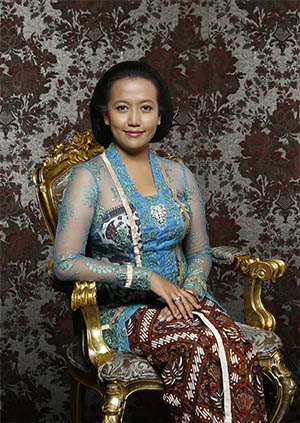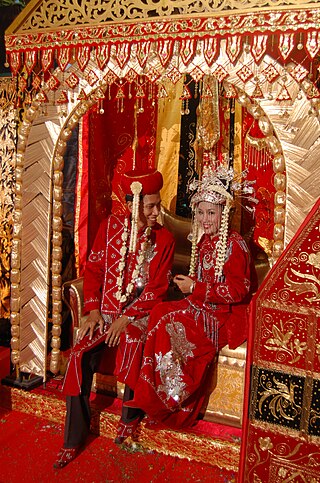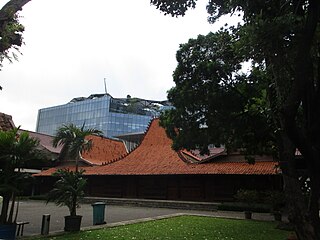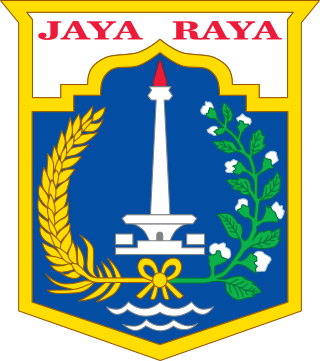
Jakarta, officially the Special Capital Region of Jakarta and formerly known as Batavia until 1949, is the capital and largest city of Indonesia. It is located on the northwest coast of Java, the world's most populous island. With more than 11.3 million inhabitants in the city proper and more than 32.5 million in the metropolitan area, Jakarta is also the largest metropolis in Southeast Asia, and serves as the diplomatic capital of ASEAN. The Special Capital Region has a status equivalent to that of a province and is bordered by two other provinces: West Java to the south and east; and Banten to the west. Its coastline faces the Java Sea to the north, and it shares a maritime border with Lampung to the west. Jakarta's metropolitan area is ASEAN's second largest economy after Singapore.

A kebaya is an upper garment traditionally worn by women in Southeast Asia, notably in Brunei, Indonesia, Malaysia, Singapore, and Southern Thailand. It is also worn in parts of southern Philippines and Cambodia.

Taman Mini Indonesia Indah is a culture-based recreational area located in East Jakarta, Indonesia. Since July 2021, it is operated by PT Taman Wisata Candi Borobudur, Prambanan, dan Ratu Boko, a subsidiary of the state-owned tourism holding company Injourney. It was operated by Yayasan Harapan Kita, a foundation established by Siti Hartinah, the first lady during most of the New Order and wife of Suharto, and run by Suharto's descendants since his death until 2021. It has an area of about 147 hectares. The project cost some US$ 26 million.

Betawi people, or Batavians, are an Austronesian ethnic group native to the city of Jakarta and its immediate outskirts, as such often described as the native inhabitants of the city. They are the descendants of the people who inhabited Batavia from the 17th century onwards.
Sentul City is a modern housing area situated at Sentul, Babakan Madang, Bogor Regency, in West Java, Indonesia. Its geographical coordinates are 6 52' 0" South, 112 26' 0" East and its original name is Sentul. Located near Bogor, it is about 48 km south of Indonesia's capital city, Jakarta. Sentul City is located at the western foot of the Jonggol Mountains, it is a mountainous township with an area of approximately 3100 hectares.

Ali Sadikin was an Indonesian politician who served as the fourth governor of Jakarta from 1966 until 1977. Prior to becoming governor, he served as Minister of Transportation from 1963 until 1966 and Coordinating Minister for Marine Affairs from 1964 until 1966. He also served as Chairman of the Football Association of Indonesia from 1977 until 1981. Born to parents of ethnic-Sundanese descent, Ali attended the Semarang Shipping Science Polytechnic during the Japanese occupation period. During the Indonesian National Revolution, he joined the People's Security Agency Navy, the predecessor to the Indonesian Navy, and fought against the Dutch during Operation Product and Operation Kraai. Following the end of the national revolution, Ali remained in the navy and fought against the Permesta rebel movement in the late 1950s.

The National Museum of Indonesia is an archeological, historical, ethnological, and geographical museum located in Jalan Medan Merdeka Barat, Central Jakarta, right on the west side of Merdeka Square. Popularly known as the Elephant Museum after the elephant statue in its forecourt, its broad collections cover all of Indonesia's territory and almost all of its history. The museum has endeavoured to preserve Indonesia's heritage for two centuries.

Setu Babakan Betawi Cultural Village or Setu Babakan is a cultural park of Betawi people, which is located at Srengseng Sawah, Jagakarsa, Jakarta in Indonesia. The village is about 5 kilometers southeast of Ragunan Zoo at the center of the Betawi Cultural Village, a site considered as part of the cultural heritage of Jakarta, which is devoted to the preservation of the indigenous Betawi culture. The location of the Betawi Cultural Village is replacement of the previous Condet (Betawi) Cultural Village which is eroded by the time.
Ivan Sagita was born in Malang 1957 and studied at the Indonesian Art Institute in Yogyakarta from 1979 to 1985. He is known as an introvert and mysterious artist, but his work of art is well known in the world of art.

South Tangerang is a city in the province of Banten, Indonesia. Located 30 km (19 mi) on the southwestern border of Jakarta, the city forms part of the Greater Jakarta metropolitan area. It was administratively separated from Tangerang Regency on 26 November 2008. According to the 2020 Census, the city population was 1,354,350 inhabitants, while the official estimate as at mid 2023 was 1,404,785 - comprising 700,754 males and 704,031 females. The total area is 164.85 km2 (63.65 sq mi). It is the second-largest city in Banten in terms of population, and has grown rapidly, not only as Jakarta's satellite city, but also the development of business districts and commerce due to presence of large-scale planned town by private developers.

The national costume of Indonesia is the national attire that represents the Republic of Indonesia. It is derived from Indonesian culture and Indonesian traditional textile traditions. Today the most widely recognized Indonesian national attires include batik and kebaya, although originally those attires mainly belong within the island of Java and Bali, most prominently within Javanese, Sundanese and Balinese culture. Since Java has been the political and population center of Indonesia, folk attire from the island has become elevated into national status.

Cultural properties of Indonesia are those items defined by Indonesian law as of "important value for history, science, and culture", and include both man-made artefacts and natural objects. The cultural properties number more than 8,000 and include ancient Hindu and Buddhist temples, mosques, historic colonial buildings, forts, art galleries, national parks and beaches. A number of the sites are World Heritage Sites.
Heri Dono is an Indonesian visual artist as artist painter, sculptor, and installation artist.

Bentara Budaya Jakarta is a cultural center located on Jalan Palmerah Selatan 17, Central Jakarta, Indonesia. The institution consists of a museum and an art gallery. Open from Monday to Friday at 8 AM to 5 PM, the gallery is closed on weekends and holidays, with an exception being made when special exhibitions are present. Entry to the gallery is free of charge and open to visitors.

The Butonese people is a collective term that embraces a number of ethnic groups of Buton and neighbouring islands in Southeast Sulawesi. Like many other ethnic groups in Sulawesi, the Butonese are seafarers and traders. Butonese have long since migrated to many parts of the Malay archipelago using smaller vessels ranging from those that can only accommodate five people to large boats that can hold up to about 150 tons of goods. In general, the Butonese are a community that inhabits the region of the historical Buton Sultanate. When the swapraja domain was abolished, so did the Buton Sultanate which ended in 1951. The area of the former Sultanate is now distributed over several regencies and cities of Southeast Sulawesi. Among them are Baubau, Buton Regency, South Buton Regency, Central Buton Regency, North Buton Regency, Wakatobi Regency and Bombana Regency.

Prajñāpāramitā of Java refers to a famous depiction of Bodhisattva Prajñāpāramitā Devi, originating from 13th century Singhasari, East Java, Indonesia. The statue is of great aesthetic and historical value, and is considered to be a masterpiece of classical Hindu-Buddhist art of ancient Java. Today, the statue is in the collection of the National Museum of Indonesia, Jakarta.
Tan Liok Tiauw Sia was a prominent Chinese-Indonesian landowner, planter and industrial pioneer in the late colonial period, best known today as the last Landheer of Batoe-Tjepper, now the district of Batuceper.

The following outline is provided as an overview of and topical guide to Jakarta:
Amrus Natalsya was an Indonesian poet, painter and wood sculpture artist. He was a political prisoner of the Suharto regime; arrested during the Transition to the New Order in 1965 for his ties to the Communist Party, he was held in prison without charge until 1973.
















